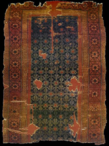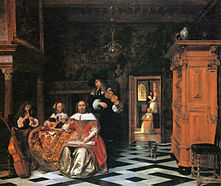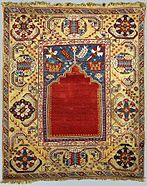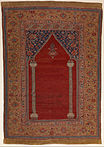
A | B | C | D | E | F | G | H | CH | I | J | K | L | M | N | O | P | Q | R | S | T | U | V | W | X | Y | Z | 0 | 1 | 2 | 3 | 4 | 5 | 6 | 7 | 8 | 9

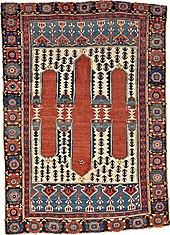
Anatolian rug or Turkish carpet (Turkish: Türk Halısı)[1] is a term of convenience, commonly used today to denote rugs and carpets woven in Anatolia and its adjacent regions. Geographically, its area of production can be compared to the territories which were historically dominated by the Ottoman Empire. It denotes a knotted, pile-woven floor or wall covering which is produced for home use, local sale, and export, and religious purpose. Together with the flat-woven kilim, Anatolian rugs represent an essential part of the regional culture, which is officially understood as the Culture of Turkey today, and derives from the ethnic, religious and cultural pluralism of one of the most ancient centres of human civilisation.
Rug weaving represents a traditional craft dating back to prehistoric times. Rugs were woven much earlier than even the oldest surviving rugs like the Pazyryk rug would suggest. During its long history, the art and craft of the woven carpet has absorbed and integrated different cultural traditions. Traces of Byzantine design can be observed in Anatolian rugs; Turkic peoples migrating from Central Asia, as well as Armenian people, Caucasian and Kurdic tribes either living in, or migrating to Anatolia at different times in history contributed their traditional motifs and ornaments. The arrival of Islam and the development of the Islamic art has profoundly influenced the Anatolian rug design. Its ornaments and patterns thus reflect the political history and social diversity of the area. Since rug export was so popular within Iran, the cultural motives and display on the Anatolian rugs vary.
Within the group of oriental carpets, the Anatolian rug is distinguished by particular characteristics of its dyes and colours, motifs, textures and techniques. Examples range in size from small pillows (yastik) to large, room-sized carpets. The earliest surviving examples of Anatolian rugs known today date from the thirteenth century. Distinct types of rugs have been woven ever since in court manufactures and provincial workshops, village homes, tribal settlements, or in the nomad's tent. Rugs were simultaneously produced at all different levels of society, mainly using sheep wool, cotton and natural dyes. Anatolian rugs are most often tied with symmetrical knots, which were so widely used in the area that Western rug dealers in the early 20th century adopted the term "Turkish" or "Ghiordes" knot for the technique. From the 1870s onwards, the Ottoman court manufactures also produced silk-piled rugs, sometimes with inwoven threads of gold or silver, but the traditional material of the majority of Anatolian rugs was hand-spun, naturally-dyed wool.
In Europe, Anatolian rugs were frequently depicted in Renaissance paintings, often in a context of dignity, prestige and luxury. Political contacts and trade intensified between Western Europe and the Islamic world after the 13th century AD. When direct trade was established with the Ottoman Empire during the 14th century, all kinds of carpets were at first indiscriminately given the trade name of "Turkish" carpets, regardless of their actual place of manufacture. Since the late nineteenth century, oriental rugs have been subject to art historic and scientific interest in the Western world. The richness and cultural diversity of rug weaving were gradually better understood. More recently, also flat woven carpets (Kilim, Soumak, Cicim, Zili) have attracted the interest of collectors and scientists.
The art and craft of the Anatolian rug underwent serious changes by the introduction of synthetic dyes from the last third of the 19th century onwards. The mass production of cheap rugs designed for commercial success had brought the ancient tradition close to extinction. In the late twentieth century, projects like the DOBAG Carpet Initiative have successfully revived the tradition of Anatolian rug weaving using hand-spun, naturally-dyed wool and traditional designs
| Part of a series on the |
| Culture of Turkey |
|---|
 |
| Languages |
| Mythology and folklore |
| Cuisine |
| Festivals |
| Religion |
| Art |
| Literature |
History

The origin of carpet weaving remains unknown, as carpets are subject to use, wear, and destruction by insects and rodents. Controversy arose over the accuracy of the claim[2] that the oldest records of flat woven kilims come from the Çatalhöyük excavations, dated to circa 7000 BC.[3] The excavators' report[4] remained unconfirmed, as it states that the wall paintings depicting kilim motifs had disintegrated shortly after their exposure.
The history of rug weaving in Anatolia must be understood in the context of the country's political and social history. Anatolia was home to ancient civilizations, such as the Hittites, the Phrygians, the Assyrians, the Ancient Persians, the Armenians, the Ancient Greeks, and the Byzantine Empire. Rug weaving is assumed to already exist in Anatolia during this time, however there are no examples of pre-Turkic migration rugs in Anatolia. In 1071 AD, the Seljuq Alp Arslan defeated the Roman Emperor Romanos IV Diogenes at Manzikert. This is regarded as the beginning of the ascendancy of the Seljuq Turks.
Seljuq rugs: Travelers' reports and the Konya fragments
In the early fourteenth century, Marco Polo wrote in the account of his travels:
...In Turcomania there are three classes of people. First, there are the Turcomans; these are worshippers of Mahommet, a rude people with an uncouth language of their own. They dwell among mountains and downs where they find good pasture, for their occupation is cattle-keeping. Excellent horses, known as Turquans, are reared in their country, and also very valuable mules. The other two classes are the Armenians and the Greeks, who live mixt with the former in the towns and villages, occupying themselves with trade and handicrafts. They weave the finest and handsomest carpets in the world, and also a great quantity of fine and rich silks of cramoisy and other colours, and plenty of other stuffs.[5]
Coming from Persia, Polo travelled from Sivas to Kayseri. Abu'l-Fida, citing Ibn Sa'id al-Maghribi refers to rug export from Anatolian cities in the late 13th century: "That's where Turkoman carpets are made, which are exported to all other countries". He and the Moroccan merchant Ibn Battuta mention Aksaray as a major rug weaving center in the early-to-mid-14th century.
The earliest surviving woven rugs were found in Konya, Beyşehir and Fostat, and were dated to the 13th century. These carpets from the Anatolian Seljuq Period (1243–1302) are regarded as the first group of Anatolian rugs. Eight fragments were found in 1905 by F.R. Martin[6] in the Alaeddin Mosque in Konya, four in the Eşrefoğlu Mosque in Beyşehir in Konya province by R.M. Riefstahl in 1925.[7] More fragments were found in Fostat, today a suburb of the city of Cairo.[8]
Judging by their original size (Riefstahl reports a carpet up to 6 m long), the Konya carpets must have been produced in town manufactories, as looms of this size can hardly have been set up in a nomadic or village home. Where exactly these carpets were woven is unknown. The field patterns of the Konya rugs are mostly geometric, and small in relation to the carpet size. Similar patterns are arranged in diagonal rows: Hexagons with plain, or hooked outlines; squares filled with stars, with interposed kufic-like ornaments; hexagons in diamonds composed of rhomboids filled with stylized flowers and leaves. Their main borders often contain kufic ornaments. The corners are not "resolved", which means that the border design is cut off, and does not continue diagonally around the corners. The colours (blue, red, green, to a lesser extent also white, brown, yellow) are subdued, frequently two shades of the same colour are opposed to each other. Nearly all carpet fragments show different patterns and ornaments.
The Beyşehir rugs are closely related to the Konya specimen in design and colour.[9] In contrast to the "animal carpets" of the following period, depictions of animals are rarely seen in the Seljuq fragments. Rows of horned quadrupeds placed opposite to each other, or birds beside a tree can be recognized on some fragments.
The style of the Seljuq rugs has parallels amongst the architectural decoration of contemporaneous mosques such as those at Divriği, Sivas, and Erzurum, and may be related to Byzantine art.[10] Today, the rugs are kept at the Mevlana Museum in Konya, and at the Turkish and Islamic Arts Museum in Istanbul.
-
Rug fragment from Eşrefoğlu Mosque, Beysehir, Turkey. Seljuq Period, 13th century.
-
Seljuq carpet, 320 x 240 cm, from Alaeddin Mosque, Konya, 13th century[11]
-
Animal carpet, dated to the 11th–13th century, Museum of Islamic Art, Doha
Rugs of the Anatolian Beyliks
Early in the thirteenth century, the territory of Anatolia was invaded by Mongols. The weakening of Seljuq rule allowed Turkmen tribes known as the Oghuz Turks to organize themselves into independent sovereignties, the Beyliks. These were later integrated into the Ottoman Empire by the sultans Bayezid I (1389-1402), Murad II (1421-1481), Mehmed the Conqueror (1451-1481), and Selim I (1512-1520).
Literary sources like the Book of Dede Korkut confirm that the Turkoman tribes produced carpets in Anatolia. What types of carpets were woven by the Turkoman Beyliks remains unknown, since we are unable to identify them. One of the Turkoman tribes of the Beylik group, the Tekke settled in South-western Anatolia in the eleventh century, and moved back to the Caspian sea later. The Tekke tribes of Turkmenistan, living around Merv and the Amu Darya during the 19th century and earlier, wove a distinct type of carpet characterized by stylized floral motifs called guls in repeating rows.
Ottoman carpets
Around 1300 AD, a group of Turkmen tribes under Suleiman and Ertugrul moved westward. Under Osman I, they founded the Ottoman Empire in northwestern Anatolia; in 1326, the Ottomans conquered Bursa, which became the first capital of the Ottoman state. By the late 15th century, the Ottoman state had become a major power. In 1517, the Egyptian Sultanate of the Mamluks was overthrown in the Ottoman–Mamluk war.
Suleiman the Magnificent, the tenth Sultan (1520-1566), invaded Persia and forced the Persian Shah Tahmasp (1524–1576) to move his capital from Tabriz to Qazvin, until the Peace of Amasya was agreed upon in 1555.
As the political and economical influence grew of the Ottoman Empire, Istanbul became a meeting point of diplomats, merchants and artists. During Suleiman I.'s reign, artists and artisans of different specialities worked together in court manufactures (Ehl-i Hiref). Calligraphy and miniature painting were performed in the calligraphy workshops, or nakkaşhane, and influenced carpet weaving. Besides Istanbul, Bursa, Iznik, Kütahya and Ushak were homes to manufactories of different specializations. Bursa became known for its silk cloths and brocades, Iznik and Kütahya were famous for ceramics and tiles, Uşak, Gördes, and Ladik for their carpets. The Ushak region, one of the centers of Ottoman "court" production, Holbein and Lotto carpets were woven here. Gold-brocaded silk velvet carpets known as Çatma are associated with the old Ottoman capital of Bursa, in Western Anatolia near the Sea of Marmara.[12]
15th century "animal" rugs
Right image: Animal carpet, around 1500, found in Marby Church, Jämtland, Sweden. Wool, 160 cm x 112 cm, Swedish History Museum, Stockholm
Very few carpets still exist today which represent the transition between the late Seljuq and early Ottoman period. A traditional Chinese motif, the fight between phoenix and dragon, is seen in an Anatolian rug today at the Pergamon Museum, Berlin. Radiocarbon dating confirmed that the "Dragon and Phoenix" carpet was woven in the mid 15th century, during the early Ottoman Empire. It is knotted with symmetric knots. The Chinese motif was probably introduced into Islamic art by the Mongols during the thirteenth century.[13] Another carpet showing two medallions with two birds besides a tree was found in the Swedish church of Marby. More fragments were found in Fostat, today a suburb of the city of Cairo.[8] A carpet with serial bird-and-tree medallions is shown in Sano di Pietro's painting "Marriage of the Virgin" (1448–52).
The "Dragon and Phoenix" and the "Marby" rugs were the only existing examples of Anatolian animal carpets known until 1988. Since then, seven more carpets of this type have been found. They survived in Tibetan monasteries and were removed by monks fleeing to Nepal during the Chinese cultural revolution. One of these carpets was acquired by the Metropolitan Museum of Art[14] which parallels a painting by the Sienese artist Gregorio di Cecco: "The Marriage of the Virgin", 1423.[15] It shows large confronted animals, each with a smaller animal inside.
More animal carpets were depicted in Italian paintings of the 14th and 15th century, and thus represent the earliest Oriental carpets shown in Renaissance paintings. Although only few examples for early Anatolian carpets have survived, European paintings inform the knowledge about late Seljuk and early Ottoman carpets. By the end of the 15th century, geometrical ornaments became more frequent.
Holbein and Lotto carpets
Based on the distribution and size of their geometric medallions, a distinction is made between "large" and "small" Holbein carpets. The small Holbein type is characterized by small octagons, frequently including a star, which are distributed over the field in a regular pattern, surrounded by arabesques. The large Holbein type show two or three large medallions, often including eight-pointed stars. Their field is often covered in minute floral ornaments. These "Ushak" carpets can be found in places such as the MAK in Vienna, the Louvre in Paris, and the Metropolitan Museum of Art.
Lotto carpets show a yellow grid of geometric arabesques, with interchanging cruciform, octagonal, or diamond shaped elements. The oldest examples have "kufic" borders. The field is always red, and is covered with bright yellow leaves on an underlying rapport of octagonal or rhombiform elements. Carpets of various sizes up to 6 meters square are known. Ellis distinguishes three principal design groups for Lotto carpets: the Anatolian-style, kilim-style, and ornamental style.[16]
Holbein and Lotto carpets have little in common with decorations and ornaments seen on Ottoman art objects other than carpets.[17] Briggs demonstrated similarities between both types of carpets, and Timurid carpets depicted in miniature paintings. The Holbein and Lotto carpets may represent a design tradition dating back to the Timurid period.[18]
-
Type I small-pattern Holbein carpet, Anatolia, 16th century.
-
The Harem Room, Topkapi Palace, carpet with a small-pattern "Holbein" design
-
Type IV large-pattern Holbein carpet, 16th century, Central Anatolia.
-
Western Anatolian ‘Lotto’-rug, 16th century, Saint Louis Art Museum
Ushak carpets
Star Ushak carpets were woven in large formats. They are characterized by large dark blue star shaped primary medallions in infinite repeat on a red ground field containing a secondary floral scroll. The design was likely influenced by northwest Persian book design, or by Persian carpet medallions.[19] As compared to the medallion Ushak carpets, the concept of the infinite repeat in star Ushak carpets is more accentuated and in keeping with the early Turkish design tradition.[20] Because of their strong allusion to the infinite repeat, the star Ushak design can be used on carpets of various size and in many varying dimensions.

Medallion Ushak carpets usually have a red or blue field decorated with a floral trellis or leaf tendrils, ovoid primary medallions alternating with smaller eight-lobed stars, or lobed medallions, intertwined with floral tracery. Their border frequently contains palmettes on a floral and leaf scroll, and pseudo-kufic characters.[21]
Medallion Ushak carpets with their curvilinear patterns significantly depart from the designs of earlier Turkish carpets. Their emergence in the sixteenth century hints at a potential impact of Persian designs. Since the Ottoman Turks occupied the former Persian capital of Tabriz in the first half of the sixteenth century, they would have knowledge of, and access to Persian medallion carpets. Several examples are known to have been in Turkey at an early date, such as the carpet that Erdmann found in the Topkapı Palace.[22] The Ushak carpet medallion, however, conceived as part of an endless repeat, represents a specific Turkish idea, and is different from the Persian understanding of a self-contained central medallion.[23]
Star and medallion Ushaks represent an important innovation, as in them, floral ornaments appear in Turkish carpets for the first time. The replacement of floral and foliate ornaments by geometrical designs, and the substitution of the infinite repeat by large, centered compositions of ornaments, was termed by Kurt Erdmann the "pattern revolution".[24]
Another small group of Ushak carpets is called Double-niche Ushaks. In their design, the corner medallions have been moved closely together, so that they form a niche on both ends of the carpet. This has been understood as a prayer rug design, because a pendant resembling a mosque lamp is suspended from one of the niches. The resulting design scheme resembles the classical Persian medallion design. Counterintuitive to the prayer rug design, some of the double niche Ushaks have central medallions as well. Double niche Ushaks thus may provide an example for the integration of Persian patterns into an older Anatolian design tradition.[9][25]
White ground (Selendi) rugs

Examples are also known of rugs woven in the Ushak area whose fields are covered by ornaments like the Cintamani motif, made of three coloured orbs arranged in triangles, often with two wavy bands positioned under each triangle. This motiv usually appears on a white ground. Together with the bird and a very small group of so-called scorpion rugs, they form a group of known as "white ground rugs". Bird rugs have an allover geometrical field design of repeating quatrefoils enclosing a rosette. Although geometric in design, the pattern has similarities to birds. The rugs of the white ground group have been attributed to the nearby town of Selendi, based on an Ottoman official price list (narh defter) of 1640 which mentions a "white carpet with leopard design".[26]
Ottoman Cairene rugs
After the 1517 Ottoman conquest of the Mamluk Sultanate in Egypt, two different cultures merged. The earlier tradition of the Mamluk carpet used "S" (clockwise) spun and "Z" (anti-clockwise)-plied wool, and a limited palette of colours and shades. After the conquest, the Cairene weavers adopted an Ottoman Turkish design.[27] The production of these carpets continued in Egypt, and probably also in Anatolia, into the early 17th century.[28]
"Transylvanian" rugs
Transylvania, in present-day Romania was part of the Ottoman Empire from 1526-1699. It was an important center for the carpet trade with Europe. Carpets were also valued in Transylvania, and Turkish carpets were used as decorative wall furnishings in Christian Protestant churches. Amongst others, the Brașov Black Church still shelters a variety of Anatolian carpets, called by convenience "Transylvanian carpets".[29] By their preservation in Christian churches, unusual as the setting may be, the carpets were protected from wear and the changes of history, and often remained in excellent condition. Amongst these carpets are well-preserved Holbein, Lotto, and Bird Ushak carpets.[30]
The carpets termed "Transsylvanian carpets" by convenience today are of Ottoman origin, and were woven in Anatolia.[30][31] Usually their format is small, with borders of oblong, angular cartouches whose centers are filled with stylized, counterchanging vegetal motifs, sometimes interspersed with shorter stellated rosettes or cartouches. Their field often has a prayer niche design, with two pairs of vases with flowering branches symmetrically arranged towards the horizontal axis. In other examples, the field decor is condensed into medallions of concentric lozenges and rows of flowers. The spandrels of the prayer niche contain stiff arabesques or geometrical rosettes and leaves. The ground colour is yellow, red, or dark blue. The Transylvanian church records, as well as Netherlandish paintings from the seventeenth century which depict in detail carpets with this design, allow for precise dating.[32][33]
Right image: "Transylvanian" type prayer rug, 17th century, National Museum, Warsaw
By the time "Transylvanian" carpets appear in Western paintings for the first time, royal and aristocratic subjects had mostly progressed to sit for portraits which depict Persian carpets.[34] Less wealthy sitters are still shown with the Turkish types: The 1620 Portrait of Abraham Grapheus by Cornelis de Vos, and Thomas de Keyser's "Portrait of an unknown man" (1626) and "Portrait of Constantijn Huyghens and his clerk" (1627) are amongst the earliest paintings depicting the "Transylvanian" types of Ottoman Turkish manufactory carpets. Transylvanian vigesimal accounts, customs bills, and other archived documents provide evidence that these carpets were exported to Europe in large quantities. Probably the increase in production reflects the increasing demand by an upper middle class who now could afford to buy these carpets.[35] Pieter de Hoochs 1663 painting "Portrait of a family making music" depicts an Ottoman prayer rug of the "Transylvanian" type.[35]
Anatolian carpets of the "Transylvanian" type were also kept in other European churches in Hungary, Poland, Italy and Germany, whence they were sold, and reached European and American museums and private collections. Aside from the Transylvanian churches, the Brukenthal National Museum in Sibiu, Romania,[36] the Museum of Fine Arts (Budapest), the Metropolitan Museum of Art, and the Skokloster Castle near Stockholm in Sweden keep important collections of "Transylvanian" carpets.
Carpets are rarely found in Anatolia itself from the transitional period between the classical Ottoman era and the nineteenth century. The reason for this remains unclear. Carpets which can be reliably dated to the eighteenth century are of a small format. At the same time, western European residences were more sparely equipped with Oriental carpets. It seems likely that carpets were not exported in large scale during this time.[37]
19th century: "Mecidi" style, and the Hereke court manufacture
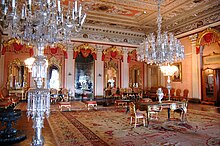
By the end of the eighteenth century, the "turkish baroque" or "mecidi" style developed out of French baroque designs. Carpets were woven after the patterns of French Savonnerie and Aubusson tapestry. Sultan Abdülmecid I (1839–1861) built the Dolmabahçe Palace, modelled after the Palace of Versailles.
A weaving workshop was established in 1843 in Hereke that supplied the royal palaces with silk brocades and other textiles. The Hereke Imperial Factory included looms that produced cotton fabric, in 1850 the cotton looms were moved to a factory in Bakirkoy, west of Istanbul, being replaced by Jacquard looms. Within its early years of production it had only produced textiles exclusively for the Ottoman palaces, and in 1878 a fire had caused extensive damage and had closed production until 1882. Carpet production had began in Hereke in 1891 and became a center for expert carpet weavers.
Hereke carpets are known primarily for their fine weave. Silk thread or fine wool yarn and occasionally gold, silver and cotton thread are used in their production. Wool carpets produced for the palace had 60–65 knots per square centimeter, while silk carpets had 80–100 knots.[38]
The oldest Hereke carpets, now exhibited in Topkapı and other palaces in Istanbul, contain a wide variety of colours and designs. The typical "palace carpet" features intricate floral designs, including the tulip, daisy, carnation, crocus, rose, lilac, and hyacinth. It often has quarter medallions in the corners. The medallion designs of earlier Ushak carpets was widely used at the Hereke factory. These medallions are curved on the horizontal axis and taper to points on the vertical axis. Hereke prayer rugs feature patterns of geometric motifs, tendrils and lamps as background designs within the representation of a mihrab (prayer niche). Once referring solely to carpets woven at Hereke, the term "Hereke carpet" now refers to any high quality carpet woven using similar techniques.
Modern history: Decline and revival
Right image: Tribal Kurdish Cuval, ca. 1880 in traditional design, with harsh synthetic colours.
The modern history of carpets and rugs began in the nineteenth century when increasing demand for handmade carpets arose on the international market. However, the traditional, hand-woven, naturally dyed Turkish carpet is a very labour-intense product, as each step in its manufacture requires considerable time, from the preparation, spinning, dyeing of the wool to setting up the loom, knotting each knot by hand, and finishing the carpet before it goes to market. In an attempt to save on resources and cost, and maximise on profit in a competitive market environment, synthetic dyes, non-traditional weaving tools like the power loom, and standardized designs were introduced. This led to a rapid breakdown of the tradition, resulting in the degeneration of an art which had been cultivated for centuries. The process was recognized by art historians as early as in 1902.[39] It is hitherto unknown when exactly this process of degeneration started, but it is observed mainly since the large-scale introduction of synthetic colours took place.[40]
In the late twentieth century, the loss of cultural heritage was recognized, and efforts started to revive the tradition. Initiatives were started aiming at re-establishing the ancient tradition of carpet weaving from handspun, naturally dyed wool.[41] The return to traditional dyeing and weaving by the producers, and the renewed customer interest in these carpets was termed by Eilland as the "Carpet Renaissance".[42]
Carpet weaving: Materials, technique, processes
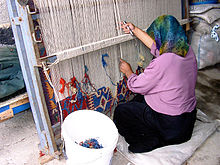
In traditional households, women and girls take up carpet and kilim weaving as a hobby as well as a means of earning money. Women learn their weaving skills at an early age, taking months or even years to complete the pile rugs and flat woven kilims that were created for their use in daily life.[43][44]
Materials
Makers of handmade rugs use only natural fibres. The most common materials used for the pile are wool, silk and cotton. Nomadic and village weavers sometimes also use goat- and camel-hair. Traditionally, spinning is done by hand. Several strands of yarn are then plied together so that the resulting yarn is strong enough to be used for weaving.
Sheep's wool is the most frequently used pile material in a Turkish rug because it is soft, durable, easy to work with and not too expensive. It is less susceptible to dirt than cotton, does not react electrostatically, and insulates against both heat and cold. This combination of characteristics is not found in other natural fibers. Wool comes from the coats of sheep. Natural wool comes in colors of white, brown, fawn, yellow and gray, which are sometimes used directly without going through a dyeing process, sheep's wool also takes dyes well. Traditionally, wool used for Turkish carpets is spun by hand. Before the yarn can be used for weaving, several strands have to be twisted together for additional strength.
Cotton is used primarily in the foundation, the warps and wefts of rugs. Cotton is stronger than wool, and, when used for the foundation, makes a carpet lie flat on the ground, as it is not as easily distorted as woolen strings. Some weavers, such as Turkomans, also use cotton for weaving small white details into the rug in order to create contrast.
Wool-on-wool (wool pile on wool warp and weft): This is the most traditional type of Anatolian rug. Wool-on-wool carpet weaving dates back further and utilizes more traditional design-motifs than its counterparts. Because wool cannot be spun extra finely, the knot count is often not as high as seen in a "wool-on-cotton" or "silk-on-silk" rug. Wool-on-wool carpets are more frequently attributed to tribal or nomadic production.
Wool-on-cotton (wool pile on cotton warp and weft): This particular combination facilitates a more intricate design-pattern than a "wool-on-wool carpet", as cotton can be finely spun which allows for a higher knot-count. A "wool-on-cotton" rug is often indicative of a town weaver. Due to their higher pile density, wool-on-cotton carpets are heavier than wool-on-wool rugs.
Silk-on-silk (silk pile on silk warp and weft): This is the most intricate type of carpet, featuring a very fine weave. Knot counts on some superior-quality "silk-on-silk" rugs can be as high as 28×28 knots/cm2. Knot counts for silk carpets intended for floor coverings should[citation needed] be no greater than 100 knots per square cm, or 10×10 knots/cm2. Carpets woven with a knot count greater than 10×10 knots/cm2 are intended to be used as a wall or pillow tapestry, because their fabric is less resistant to mechanical stress. These very fine, intricately-woven rugs and carpets are usually no larger than 3×3 m.
Dyes and dyeing

Traditional dyes used for Anatolian carpets are obtained from plants, insects and minerals. In 1856, the English chemist William Henry Perkin invented the first aniline dye, mauveine. A variety of other synthetic dyes were invented thereafter. Cheap, readily prepared and easy to use as they were compared to natural dyes, their use is documented in Ushak carpets already by the mid 1860s. The tradition of natural dyeing was recently revived, based on chemical analyses of natural dyes from antique wool samples, and experimental re-creation of dyeing recipes and processes, in the early 1980s.[45][46]
According to these analyses, natural dyes used in Anatolian rugs include:
- Red from Madder (Rubia tinctorum) roots,
- Yellow from plants, including onion (Allium cepa), several chamomile species (Anthemis, Matricaria chamomilla), and Euphorbia,
- Black: Oak apples, Oak acorns, Tanner's sumach,
- Green by double dyeing with Indigo and yellow dye,
- Orange by double dyeing with madder red and yellow dye,
- Blue: Indigo gained from Indigofera tinctoria.
The dyeing process involves the preparation of the yarn in order to make it susceptible for the proper dyes by immersion in a mordant, immersing the yarn in the dyeing solution, and leaving it to dry exposed to air and sunlight. Some colours, especially dark brown, require iron mordants, which can damage or fade the fabric. This often results in faster pile wear in areas dyed in dark brown colours, and may create a relief effect in antique Turkish carpets.
With modern synthetic dyes, nearly every colour and shade can be obtained so that it is nearly impossible to identify, in a finished carpet, whether natural or artificial dyes were used. Modern carpets can be woven with carefully selected synthetic colours, and provide artistic and utilitarian value.[47]
The Anatolian rug is distinct from carpets of other provenience in that it makes more pronounced use of primary colours. Western Anatolian carpets prefer red and blue colours, whereas Central Anatolian use more red and yellow, with sharp contrasts set in white.[48]
Weaving and finishing




A variety of tools are needed in the construction of a handmade rug. A loom, a horizontal or upright framework, is needed to mount the vertical warps into which the pile nodes are knotted, and one or more shoots of horizontal wefts are woven ("shot") in after each row of knots in order to further stabilize the fabric. Wefts can be either undyed or dyed, mostly in red and blue.
The pile knots are usually knotted by hand. Most rugs from Anatolia utilize the symmetrical Turkish double knot. Each knot is made on two warps. With this form of knotting, each end of the pile thread is twisted around two warp threads at regular intervals, so that both ends of the knot come up between two strands on one side of the carpet. The thread is then pulled downwards and cut with a knife.
After a row of knots has been inserted, one or two, sometimes more, rows of wefts are woven in, and the fabric is compacted by beating with a heavy comb. Once the carpet is finished, it is cut from the loom. The sides or selvages are usually overcast in wool. The selvages consist of up to ten warp threads. Especially village and nomadic rugs have flat-woven kilim ends, sometimes including pile-woven tribal signs or village crests. The pile of the carpet is shorn with special knives in order to obtain an equal surface. In some carpets, a relief effect is obtained by clipping the pile unevenly. Finally, the carpet is washed before it is used, or goes to the market.
The upright pile of Turkish rugs usually falls in one direction, as knots are always pulled down before the string of pile yarn is cut off and work resumes on the next knot, piling row after row of knots on top of each other. When touching a carpet, this creates a feeling similar to stroking an animal's fur. This can be used to determine where the weaver has started knotting the pile. The pile in Turkish carpets is usually between 2 and 4 mm thick. Coarse nomadic rugs like the Yürük rugs, can be as thick as 12 mm. A special bedding carpet called yatak may reach a pile thickness of 20 to 25 mm.
Origins and traditions of Anatolian rug design
Anatolian rug design integrates different strands of traditions. Specific elements are closely related to the history of Turkic peoples and their interaction with surrounding cultures, in their central Asian origin as well as during their migration, and in Anatolia itself. The most important cultural influences came from the Chinese culture, and from Islam. Carpets from the Bergama and Konya areas are considered as most closely related to earlier Anatolian rugs, and their significance in the history of the art is now better understood.[49]
Central Asian traditions

The early history of the Turkic peoples in Central Asia is closely related to China. Contacts between Turks and China are documented since the early Han dynasty.
In his essay on centralized designs, Thompson[50] relates the central medallion pattern, frequently found in Anatolian rugs to the "lotus pedestal" and "cloud collar (yun chien)" motifs, used in the art of Buddhist Asia, which he dated back to Yuan dynasty China. Recently, Brüggemann further elaborated on the relationship between Chinese and Turkic motifs like the "cloud band" ornament, the origin of which he relates to the Han dynasty.[51] The early Anatolian "Phoenix and Dragon rug" depicts another traditional motif of Chinese mythology, the fight between the phoenix (Fenghuang) and the dragon.[52]
Romano-Hellenistic traditions
There are documentary records of carpets being used by the ancient Greeks. Homer writes in Ilias XVII,350 that the body of Patroklos is covered with a "splendid carpet". In Odyssey Book VII and X "carpets" are mentioned. Pliny the Elder wrote (nat. VIII, 48) that carpets ("polymita") were invented in Alexandria. It is unknown whether these were flatweaves or pile weaves, as no detailed technical information can be gained from the texts.
Athenaeus of Naucratis describes luxurious carpets in his Deipnosophists, written about 230 AD.
"And under these there were strewed purple carpets of the finest wool, with the carpet pattern on both sides. And there were handsomely embroidered rugs very beautifully elaborated on them." (Book V, p. 314)
" to lie on a couch with silver feet, with a smooth Sardian carpet spread under it of the most expensive description." (Book VI, p. 401)[53]
A carpet "with the pattern on both sides" could either be a flat-woven, or pile-woven carpet. Whether "purple" refers to the colour of the fabric or to the dyestuff (either Tyrian purple or madder red could have been used) remains unknown. The town of Sardis lies in Western Anatolia, thus, this may be the earliest reference to carpet production in the region of Asia minor.
Anatolia was ruled by the Roman Empire since 133 BCE. The East Roman (Byzantine) and Sasanian Empires have coexisted for more than 400 years. Artistically, both empires have developed similar styles and decorative vocabulary, as exemplified by mosaics and architecture of Roman Antioch.[54] A Turkish carpet pattern depicted on Jan van Eyck's "Paele Madonna" painting was traced back to late Roman origins and related to early Islamic floor mosaics found in the Umayyad palace of Khirbat al-Mafjar.[55] The architectural elements seen in the Khirbat al-Mafjar complex are considered exemplary for the continuation of pre-Islamic, Roman designs in early Islamic art.[56]
Islamic traditions

When Turkic migrants moved from Central Asia to Anatolia, they were migrating mainly through lands which had already adopted Islam. Depicting animals or humans is prohibited in the Islamic tradition, which does not distinguish between religious and profane life. Since the codification of the Quran by Uthman Ibn Affan in 651 AD/19 AH and the UmayyadAbd al-Malik ibn Marwan reforms, Islamic art has focused on writing and ornament. The borders of Anatolian rugs frequently contain ornaments which were derived from Islamic calligraphy. Usually, these "kufic" borders consist of lam-alif- or alif-lam sequences in an interwoven pattern.
The main fields of Anatolian rugs are frequently filled with redundant, interwoven patterns in "infinite repeat". Thus, the rug represents a section of an infinite pattern, which is imagined as continuing beyond its borders and into the infinite.
A specific Islamic pattern is the mihrab pattern which defines the Prayer rug. A prayer rug is characterized by a niche at one end, representing the mihrab in every mosque, a directional point to direct the worshipper towards Mecca. The mihrab pattern in Turkish carpets is often modified and may consist of a single, double, or vertically or horizontally multiplied niche. Thus the niche pattern can range from a concrete, architectural to a more ornamental understanding of the design. Prayer rugs are often woven "upside down", as becomes apparent when the direction of the pile is felt by touching the carpet. This has both technical (the weaver can focus on the more complicated niche design first), and practical reasons (the pile inclines in the direction of the worshipper's prostration).
Other cultural influencesedit

Large, geometric shapes are considered to be of Caucasian or Turkmen origin. The Caucasian tradition may have been integrated either by migrating Turkish tribes, or by contact with Turkmen people already living in Anatolia.[57]
A central medallion consisting of large, concentrically reduced rhomboid patterns with latch-hook ornaments is associated with the Yörük nomads of Anatolia. The name Yürük is usually given to nomads whose way of life has changed least from its central Asian origin.[58]
In Anatolia, several ethnic minorities have maintained separate traditions, e.g., the Greek, Armenians, and Kurds. Whilst Greeks and Armenians were involved in carpet weaving and trading in the past, no design motifs have been clearly associated with their distinct, Christian culture. Kurdish rug design differs from Anatolian. Kurdish rugs are more often discussed together with Persian carpets.[58]
Social context: Court and town, village and nomadic productionedit
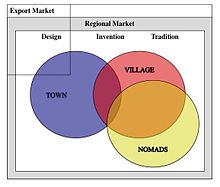
Carpets and rugs were simultaneously produced by and for the four different social levels of court, town, rural village, and tribe.[25] Elements of town design were often reproduced in rural production, and integrated by the village weavers into their own artistic tradition by a process called stylization.
Court manufactureedit
Representative "court" rugs were woven by special workshops, often founded and protected by the sovereign, with the intention to represent power and status. As such, representative carpets have developed a specific design tradition influenced by the courts of the surrounding empires.[59] Rugs were produced in the court manufactures as special commissions or gifts. Their elaborate design required a division of work between an artist who created a design plan (termed "cartoon") on paper, and a weaver who was given the plan for execution on the loom. Thus, artist and weaver were separated.[9][25]
Town and village productionedit
Carpets were woven in town manufactures by organized manufactories. Usually, town manufactures have a larger range of patterns and ornaments and more artistically developed designs which can be executed by the weavers, the palette of colours is rich, and the weaving technique may be finer due to their access to high-quality wool, and the employment of specialized weavers. Larger formats can be produced on the larger, stationary looms. Carpets are woven from cartoons, using material provided by the manufacturer. The town manufactories may accept commissions even from foreign countries, and produce carpets for export.[25]
Rugs produced in villages are often produced in individual homes, but at least partly commissioned and supervised by guilds or manufacturers. Home production may not require full-time labour, but could be performed when time allows, besides other household tasks. Village carpets as essential household items were part of a tradition that was at times influenced by, but essentially distinct from the invented designs of the workshop production. Frequently, mosques had acquired rural carpets as charitable gifts, which provided material for studies.[60] Rural carpets rarely include cotton for warps and wefts, and almost never silk, as these materials had to be purchased on the market by the individual weaver.
Patterns and ornaments from court manufactory rugs were reproduced by smaller (town or village) workshops. This process is well documented for Ottoman prayer rugs.[61] As prototypical court designs were passed on to smaller workshops, and from one generation to the next, the design underwent a process termed stylization, comprizing series of small, incremental changes either in the overall design, or in details of smaller patterns and ornaments, over time. As a result, the prototype may be modified to an extent as to be barely recognizable. Initially misunderstood as the "degeneration" of a design, the process of stylization is now regarded as a genuine creative process within a distinct design tradition.[61]
Stylization in Anatolian prayer rug design
-
Ottoman court prayer rug, Bursa, late 16th century (James Ballard collection, Metropolitan Museum of Art)
-
Turkish prayer rug
-
Bergama prayer rug, late 19th century
Nomadic and tribal productionedit
With the end of the traditional nomadic lifestyle in Anatolia, and the consequent loss of specific traditions, it has become difficult to identify a genuine "nomadic rug". Social or ethnic groups known for their nomadic lifestyle like the Yürük or Kurds in contemporary Turkey have in large parts acquired sedentary lifestyles. Some aspects of the tradition, like the use of specific materials, dyes, weaving or finishing techniques or designs may have been preserved, which can be identified as specifically nomadic or tribal.
Criteria for a nomadic production include:[62]
- Unusual materials like warps made of goat's hair, or camel wool in the pile;
- high quality wool with long pile (Anatolian and Turkmen nomads);
- small format fitting for a horizontal loom;
- irregular format due to frequent re-assembly of the loom, resulting in irregular tension of the warps;
- pronounced abrash (irregularities within the same colour due to dyeing of yarn in small batches);
- inclusion of flat weaves at the ends.
Within the genre of carpet weaving, the most authentic village and nomadic products were those woven to serve the needs of the community, which were not intended for export or trade other than local. This includes specialized bags and bolster covers (yastik) in Anatolia, which show designs adapted from the earliest weaving traditions.[63]
Regionsedit

Anatolia can be divided into three major areas of rug production, centered around local towns and marketplaces, which often lend their names to the rugs produced in the surrounding area. Western, Central, and Eastern Anatolia have distinct weaving traditions. However, commercially produced rugs are often woven irrespective of local design traditions. Preferential use of different materials and dyes, as well as characteristic designs, sometimes allow for a more specific assignment of a carpet to one of the three regions, or to a more specific weaving place.


